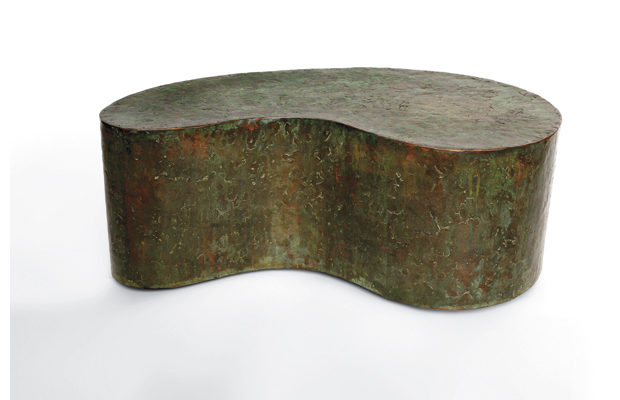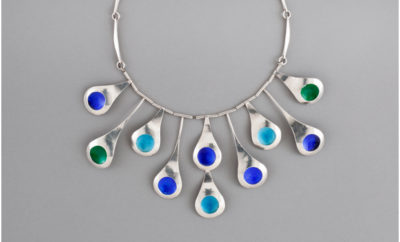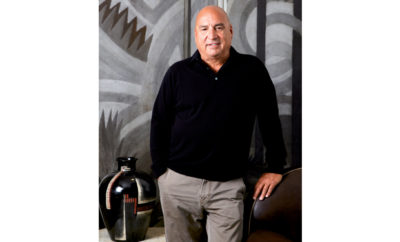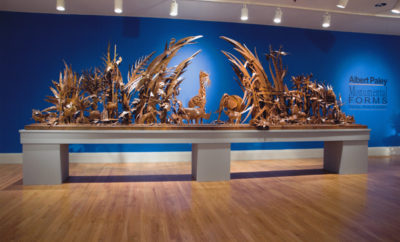
Design
[From the archives] Mettle Work
With six years under its belt, MODERN Magazine delves into its archives to take another look at the people, places and things that have kept us inspired. This interview with Silas Seandel was originally published in our Fall 2009 issue.
A visit with Silas Seandel: artisan, sculptor, furniture-maker, and master of metal

Seandel’s “Terra” table has a formstone top incised with channels filled with bronze. The base is cast bronze. Photos courtesy of Silas Seandel Studio except where noted.
These days—when design is taught via computer programs, and art students seem as calculating as finance majors—hands-on, largely self-taught studio artist-craftsmen are a vanishing breed. Silas Seandel, born in Brooklyn in 1937, has been keeping the fires of the tradition alive since the early ‘60s. In recent seasons, his singular pieces have won him a wide following among collectors. Seandel’s metal-based tables—his preferred form for what he calls “sculptural furniture”—generally fetch between $5,000 and $7,000 from design dealers. “Clients come in and say, ‘That table is fantastic—who did it?’” says Kurt Ducovna, co-owner of Modern Galere, a West Palm Beach design 44 dealership. “I think Seandel is still an under-known talent. His work falls between art and furniture. He is daring, and there is a kind of sensuousness in his use of metal.” MODERN spoke with Seandel, still hard at work on sculpture and furniture commissions, in his workspace and showroom in Manhattan’s Chelsea district.
It must be nice, being in the center of the New York art world.
Yes, but it’s a coincidence.This is my fifth studio in New York—and my last. I’ve been here since 1978. Back then these places were all auto-body shops and warehouses.
You earned an economics degree from the University of Pennsylvania. Kind of an odd choice for someone with an artistic bent.
I didn’t know I had an artistic bent. After I left the service, I had no idea what to do. A family friend suggested that a business major was a safe path. I did the homework and got good grades. But I didn’t learn anything.

The “Jools” cocktail table has a glass top inset into a solid cast-metal base—bronze in this example, though it can be made of copper, steel, or almost any metal.
So how did you discover your path?
Well, I was always a tinkerer. I liked to work with my hands, and took clay-modeling classes in college. I was intrigued by Calder. I made little mobiles and models but it was just a hobby. One week in 1963, I went to Cape Cod. I had a couple of hours to kill in Provincetown, waiting for a friend to meet me, so I went to [the Walter P. Chrysler] museum, where they had a show about sculptures of the ‘50s. I saw metal sculptures by John Chamberlain, Jason Seley, and Richard Stankiewicz, and thought, “Wow! That’s what I want to do!”
What was it about metal that inspired you?
It goes back to Calder— that perfect joinery of parts. Metal is wonderful: it’s strong, durable, impervious, but at the same time it can be flexible and formable. I loved to see molten metal flow.
And then? I went back to New York, bought a book on welding, and set up a studio in the kitchen of my walk-up apartment in the Village. I started experimenting and learning technique Modern using tin cans. It was illegal, of course. I 46 had to smuggle in welding torches and fuel tanks. But I learned—mostly from the mistakes I made.

A brass variant on Seandel’s welded sheet metal “Convoluted Tree Truck” table. Photo courtesy of Galere, West Palm Beach.
Were you showing your work to art galleries?
Oh, no. I still had so much technique to learn. I was dirt poor. I bagged groceries in the neighborhood, and worked as a stockboy at [the now-defunct department store] B. Altman. But I spent every free minute working on metal.
What was your “big break”?
There were two, really. One was almost an accident. Altman got the contract to renovate a country club in Westchester County, and the guy in charge of the project knew I was an aspiring sculptor. He asked me to make a wall sculpture for the dining room— it showed golfers in different phases of a swing. A lot of decorators saw it, and started to call me with commissions. Also, about that time they were opening the D&D Building [the Decoration & Design Building in midtown Manhattan, which houses dozens of showrooms]. Friends said I should put my work on display in one place, so I borrowed $30,000, rented a space, and got so much business from decorators, and department stores like Neiman Marcus and Gump’s, that I was able to pay back the loan in three months.

Seandel often alters his designs—a “Volcano” form reworked as coffee table is shown—to accommodate new aesthetic ideas, or new uses.
How did you come to take up furniture?
Because of fakes. I learned that people were making copies of the pieces in my catalogue, and doing a sloppy job of it. So I decided to make furniture.You can’t fake furniture—the craftsmanship is much more demanding. You have to get the balance and proportions just right.
What techniques do you use?
Two, mainly. Some pieces are made of rolled sheet metal that is cut into forms that are welded together, then ground and polished.The other method is metal- casting, usually using bronze or copper.
Most of your pieces have a similar format: a glass top with …
That’s so you can see the sculptural metal base, which I think is the most important part, naturally.
Of course. So your pieces with stone-and-metal tops are a departure.
The idea is actually old. But it took a long time to realize, because I had to do a lot of experimenting to create a form-stone in which I could create fissures to fill with veins of metal. It’s called the “Terra” table. It’s meant to resemble a vertical slice of rock, with creases of ore running through it.

The two-foot tall “Volcano” and “Twigs”end tables executed in cast bronze.
Looking around at all these examples of your work, it’s easy to tell that they were all made by the same hand. Yet you don’t have a signature style, really.
Part of that is the beauty of metal—you can do anything with it.Mostly, I follow my instincts.That has always stood me in good stead. I get an image in my head, and I just go with it. I don’t dwell on a particular form. Because of that, I have a fairly large body of work in which each piece is distinctive. Some works are similar, but no two are identical.
What’s going on for you now?
Well, I recently finished a pretty large public sculpture commission—a fifteen-foot- tall stainless-steel-and-bronze 9/11 memorial for the grounds of Greenwich Hospital in Connecticut. Other than that, I have a good roster of clients, so it’s just the usual: day-to-day hard work. I have two assistants who have each been with me for more than thirty years. But working with this stuff, especially at my age, is tough.
Ever thought about taking up a new, perhaps lighter, material? Nah. I’m too in love with my welding torch.












